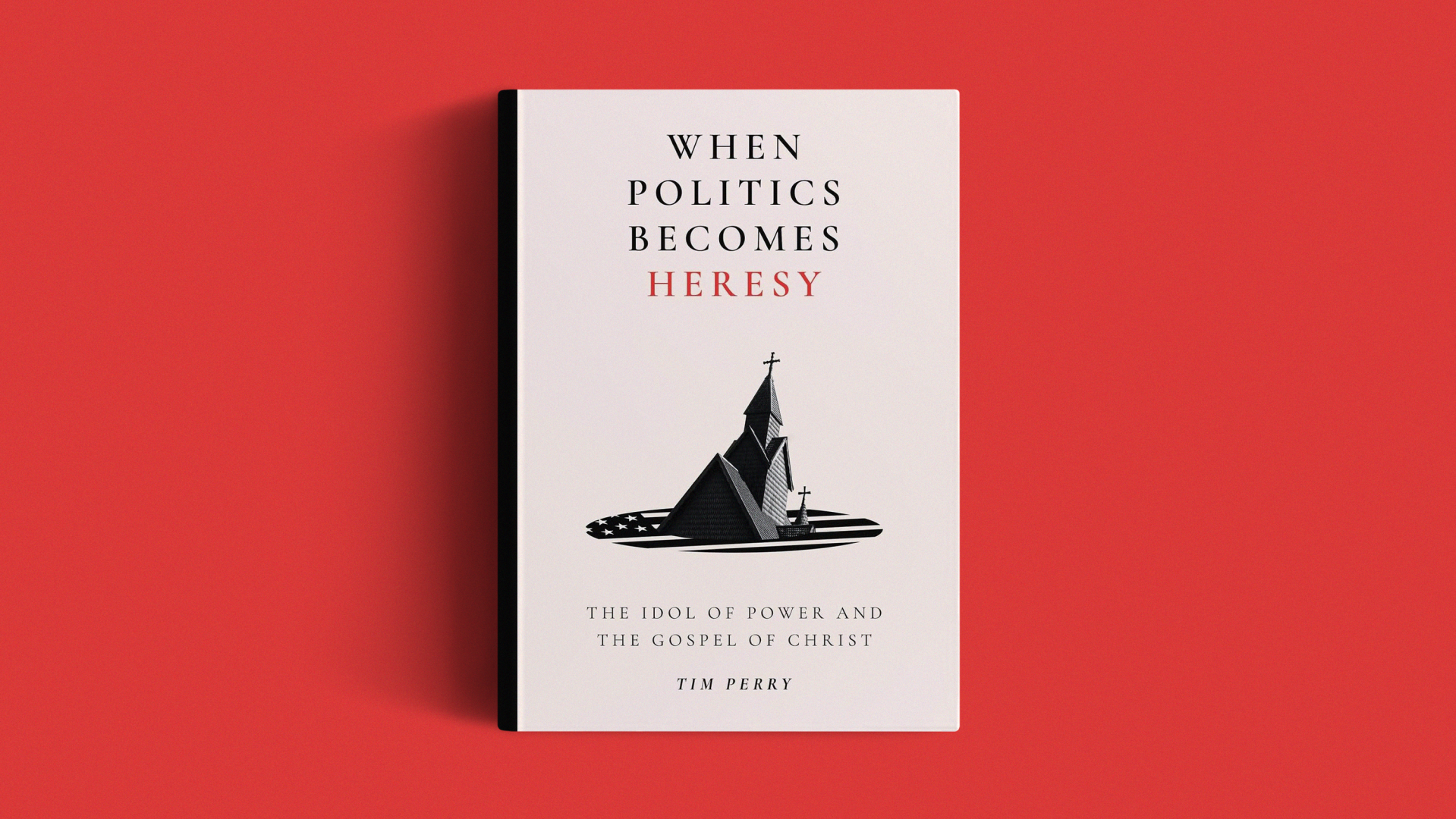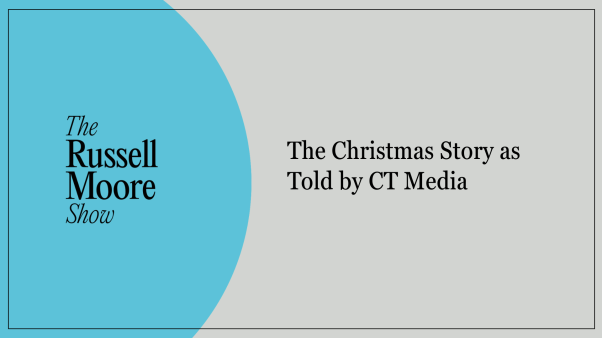If we can learn anything from the history of Christian heresies, it is that they never truly vanish. Instead, they resurface in every generation with new twists.
When Politics Becomes Heresy: The Idol of Power and the Gospel of Christ
Lexham Press
200 pages
$7.21
Tim Perry sets out to identify the modern twists on ancient heretical teachings in a new book, When Politics Becomes Heresy: The Idol of Power and the Gospel of Christ. The term heresy originates with an ancient Greek word meaning “choice” or “the thing chosen,” and Perry believes many evangelicals have consciously chosen to embrace a mixture of politics and religion that is dangerously close to heresy.
Perry, a Lutheran pastor in the Canadian province of Manitoba, styles the book in the form of a catalog of heresies, akin to what the ancient church called a Panarion, a Greek term meaning something like “medicine chest.” Such works offered Wikipedia-like entries detailing the origins, essential doctrines, and key representatives of each heresy, along with suggested “cures.”
Early Christian theologians, such as the fourth-century bishop Epiphanius, drafted versions of these catalogs to help Christian leaders identify how heretical doctrines might be creeping into their congregations. Perry’s work attempts something similar. While the contemporary heresies differ from their ancient expressions—no evangelicals hold to the Gnostic hierarchy of “aeons,” for example—key features and false teachings persist.
Perry’s chief worry, as his title suggests, is a habit of allowing politics to displace the spiritual life. In his view, the church too often sees the voting booth, rather than the altar, as the place where God is most powerfully at work. Perry believes leading 20th-century evangelicals, like Harold John Ockenga and early CT editor Carl F. H. Henry, would share his concerns about the movement they helped shape.
As he argues, they would recognize “the loss of transcendence and the substitution of politics as a grave spiritual malady that requires spiritual medicine—namely, repentance—to cure it.”
Perry organizes his book around five heresies: Simony, Gnosticism, Arianism, Pelagianism, and Donatism.
Throughout church history, Simony has referred to the trafficking of religious things, often in the form of buying and selling church offices. The name derives from Simon Magus, the false convert in the Book of Acts who tries to buy the power to impart the Spirit (8:18). In medieval and Reformation churches, where politics and religion were more closely aligned, Simony was a common problem.
To understand the dynamics of Simony today, Perry appeals to the writings of Charles Taylor, author of the landmark book A Secular Age. He focuses on Taylor’s concepts of the “social imaginary,” the “immanent frame,” and the “buffered self,” showing how these terms capture a tendency to focus exclusively on the present moment and the political maneuverings that give it shape.
In this context, Perry writes, Simony means expecting the Bible “to speak immediately to a modern political matter, as though there is absolutely no room for reflection or disagreement.” When evangelicals misuse Scripture in this manner, he argues, they “traffic” it as a means of gaining political and cultural power.
Gnosticism is another heresy Perry finds lurking among evangelical communities. Gnostics, as he describes them, were an assortment of religious groups that were “entirely wedded to the spirit of their age.” They blended Christianity with other ancient religions and philosophical views, especially versions of Plato’s philosophy that viewed the immaterial realm as better and nobler than embodied life on earth.
As a result, their thinking embraced various dualisms that distinguished between spiritual and material realities. Gnosticism, writes Perry, encourages the “instrumentalization of matter, especially the body,” which it regards as inhibiting to the true spiritual life.
Perry sees parallels in the evangelical desire to maintain its relevance to modern culture by trying to embrace both trendy philosophies and the gospel. In its heyday, he argues, evangelicalism was a renewal movement fueled by a “well-defined sense of otherness.” He worries, however, that today’s evangelicals have lost this mentality, resulting in a “view of Jesus, whether on the right or left, [that] bears little resemblance to the Jesus of the Bible.”
Arianism, Pelagianism, and Donatism are the three heresies that round out Perry’s contemporary catalog. Regarding Arianism, he stresses that Arius, the early theologian and namesake of the heresy, was “conservative” in the sense of revering the Bible. Yet he also denied the full deity of the Son, which had crippling implications for the doctrine of salvation.
Perry suggests that evangelicals are often too pragmatic to see the consequences of subtle but dangerous innovations like Arianism, much less contend against them. “Even in our Christology,” he writes, “evangelicals tend to put the doctrine’s usefulness ahead of its truth.”
Pelagianism undermined the doctrine of original sin, claiming that even fallen human beings could attain sinless perfection through their own efforts. For the theologian Pelagius, Perry notes, “grace indeed accompanied both the will to do the good and the act itself, but grace was itself dependent on the free decision of the human will.”
Perry sees the modern temptation of Pelagianism in popular self-help movements that some evangelicals embrace. He writes, “What we see in the moral self-improvement of the evangelical right and the social transformation of the evangelical left is a false and finally Pelagian gospel that expects us to bootstrap our own moral and social perfection.” Once we embrace this kind of Pelagianism, Perry argues, we lay the groundwork for a hyper-partisan competition over which side’s agenda produces the best moral outcomes.
The Donatists, to consider Perry’s final example, were looking for the perfect church, unaffected by the sins of the fallen world. The Donatist controversy, as church historians call it, has roots in the Roman Empire’s persecutions of early Christians. The Donatists wanted to purge the church of those who, in some way, capitulated to pagan pressure to disavow Christ and worship false gods. For the Donatists, the Christians that “lacked such holiness weren’t actually members” of the authentic church.
Many issues arise when studying the Donatist movement, but in Perry’s analysis, one of the most important is the relationship between the church and the world—a conundrum that continues to divide evangelicals across the political spectrum. Perry asks a challenging question: How can we define norms of genuine Christian holiness at a moment when Christians have divided political loyalties and competing visions of cultural engagement?
In each chapter, Perry explains how the church can root out the modern versions of ancient heresies. His proposed solution to Simony, for example, is cultivating the virtue of prudence, which he describes as “the use of proper caution; deliberation in decision-making; using reason in both self and community governance.” Prudence demands communities whose members value careful thought, listen to expertise, and deliberately work to guide each other down the narrow path of biblical faithfulness.
Perry’s solution to Gnosticism is embracing moral and biblical realism, or what C. S. Lewis called the “Tao.” Evangelicals, in this view, should take greater pains to guard against letting any earthly philosophy supplant the morality of Scripture and the biblical story of salvation through Christ.
Turning to Arianism, Perry recommends a renewal of basic discipleship in the doctrine of the incarnation, a habit of confessing the Nicene Creed in worship, and patterns of reading Scripture in accordance with the Trinitarian theology that the creed affirms.
Similarly, regarding Pelagianism, he simply asks the church to reclaim the gospel and to reject the temptation of building the kingdom on our own. As he writes, we cannot “vote for God, nor by our votes or other forms of engagement bring in God’s kingdom.” But we can pray for our leaders, bear witness to God’s reign within our own spheres of influence, and testify to the good news of the gospel.
Finally, Perry argues that overcoming modern forms of Donatism involves learning to cultivate honest debates on important issues. As he emphasizes, this entails a “deliberate commitment to the investigation and, if necessary, condemnation of wrong ideas.”
The common theme running through all of Perry’s critiques concerns the perennially contested relationship between church and politics. A good summary of his thought lies in the quote he cites from Anglican scholar Oliver O’Donovan: “The Church has only the authority to persuade; when it gets itself mixed up in the authority given by God to the magistrate, namely, the authority to compel, there is no end to the mischief that results.”
Perry is surely correct that many evangelicals confuse the spheres of church and politics in ways that fall short of biblical faithfulness. Yet even where his indictments are well justified, they often lack a measure of specificity.
In defending his approach, Perry notes that too much specificity can distract readers from seeing broader patterns of heretical drift within evangelical communities. On the other hand, erring too far on the side of generalities arguably allows greater leeway for assuming that only other sorts of evangelicals are to blame.
It’s possible too that Perry has failed to exhaust the ways that contemporary heresies and related false doctrines manifest themselves in Christian circles. Take, for example, his discussion of Gnosticism.
The Gnostic tendency to instrumentalize the material world has all kinds of implications for how we understand the meaning of human life and the significance of divine of creation, especially in a technological age. How, one might ask, is the material world being instrumentalized today, and how should Christians respond?
The language of heresy is serious business, and in some cases, the book perhaps leans on it too strongly. Perry knows the term should not be used lightly, because heresy implies the damnation of souls. But he argues, “I have deliberately cast that indictment as heresy to indicate that it is a spiritual problem first.” This is a helpful clarification, because readers might not always see the connections between their spiritual lives and their political engagement.
But heresies also concern core Christian beliefs, not secondary issues of doctrinal disagreement or principled decisions about temporal political affairs. In a climate of intense partisan conflict, one pressing challenge is balancing the imperatives of seeking church unity (John 17:21) and purging the evil among us (1 Cor. 5:13), all the while engaging the world with the gospel. To that end, readers will need to evaluate the sins Perry describes on a case by case basis: Do they rise to the level of heresy, or are they are matters of principled disagreement on how the church should engage the surrounding culture?
Ideally, the kind of self-examination Perry advocates can lead to healthier forms of cultural engagement. I do hope, though, that Perry’s arguments do not lead readers to retreat from active citizenship in their local contexts or to dismiss the very idea of creating and maintaining secular political spaces. Either way, such considerations underscore the importance of local pastors and thoughtful Christian leaders, who help us navigate the tension of living as citizens of the city of God while acting as salt and light in the city of man.
Perry’s book is helpful in recovering an awareness of ancient heresies and showing how these errors never truly go away. May the church today heed his exhortations, seeking “prudence and patience, faithfulness in witness, and a political civility” in an age marked by sharp lines of political division. I think both early church fathers and 20th-century evangelical stalwarts would give that vision a hearty amen.
Stephen O. Presley is senior fellow for religion and public life at the Center for Religion, Culture & Democracy and associate professor of church history at The Southern Baptist Theological Seminary. He is the author of Cultural Sanctification: Engaging the World Like the Early Church.





















